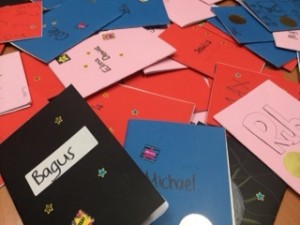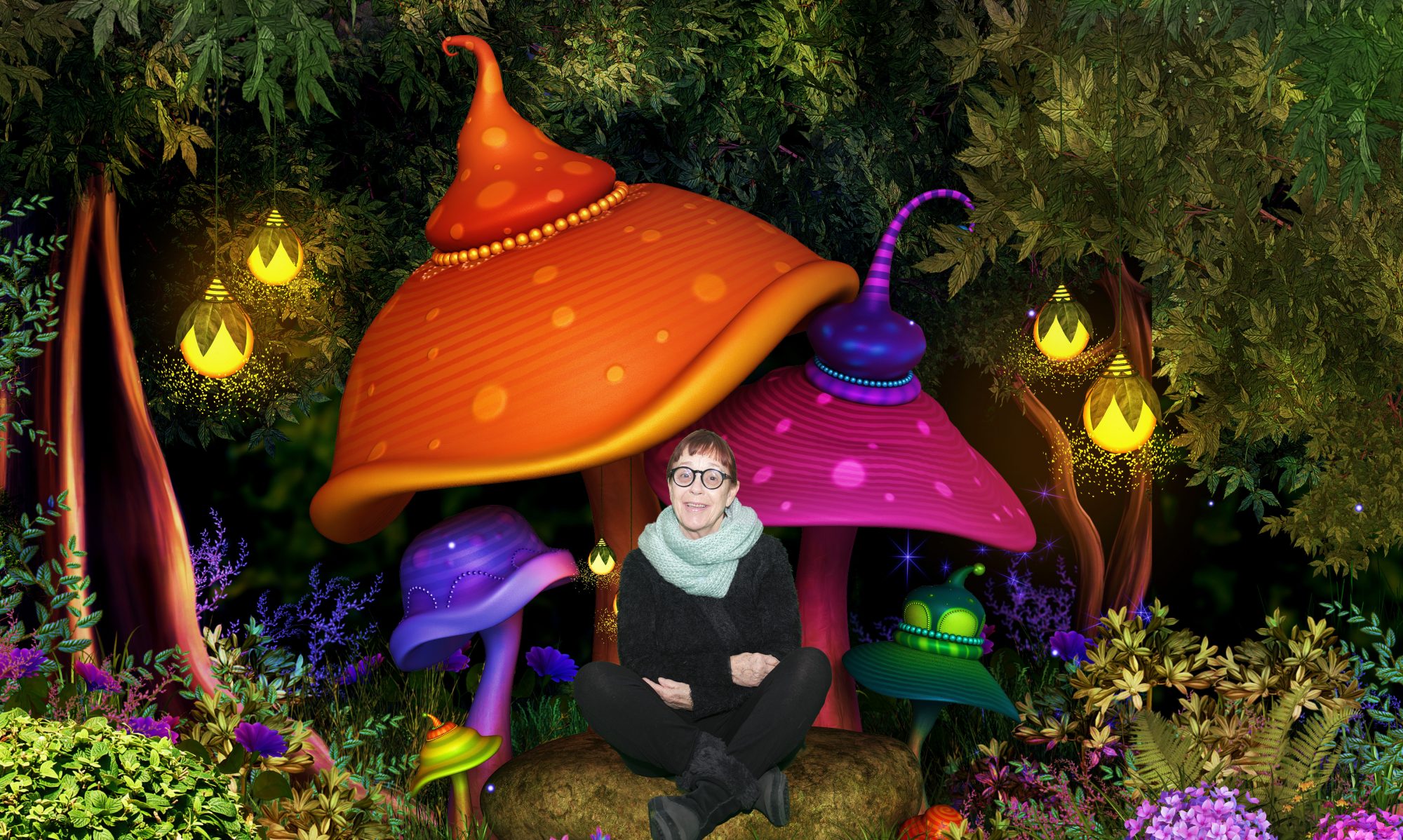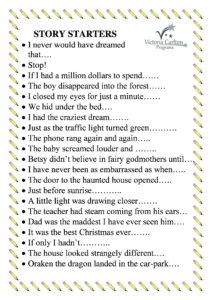I often joke about how many of our students seem to have holes in their elbows and their wonderful ideas drop out before they hit the page!
I think we forget how hard it is for children to coordinate ideas, handwriting, concentration, punctuation etc and get ideas down.
My favourite lesson every day is WRITING and I am amazed as I see the creative process begin anew with each lesson.
The blank page is transformed- one minute it is empty- the next there are ideas, “wonderings”, creative “splats” and sadly sometimes one word and a pencil that just won’t move!
When I ask children what they would like to write they describe how they have many ideas and just cannot choose. Sometimes they have a HUGE idea and they are frightened to begin because it will take so long to write or they feel they cannot spell the words.
There are so many variables and teachers need a very full tool-box and a huge dose of understanding to be able to effectively teach written expression.
We sometimes use story starters- especially when children are tired and we are approaching the end of the year.
As children LOVE random choices, we often cut these up and they take one as a lucky dip. They act as “circuit breakers” so their brains can zoom in on just one idea!
If I give them too many topics to choose from they will get into the “kangaroo caught in the spotlight” syndrome and simply stop!
I have given you some of our story starters here and invite you to try them out. We are always devising more and at the moment we are working on a new Christmas set.
We share all our writing strategies in our writing workshop for teachers- ALL KIDS CAN WRITE. Please contact me if you would like to attend the forthcoming ones in Perth, Adelaide, Brisbane or Singapore.
CAN WE FIX THE HOLE IN YOUR CHILD’S ARM?
Many parents and teachers come to us with problems associated with reluctant writers. Their children are simply not able to transfer their thoughts to paper even though they have very creative ideas.
Many children are not able to sift through the myriad possibilities when asked to write freely – they often need some guidelines. These children often think on all levels at once and find it extremely difficult to order their thoughts and know where to start.
Some children are perfectionist in nature and know their written efforts will not be as good as they wish.
No matter what the cause- the effect is the same! Ideas and words just drop out of the elbow before they reach the pencil. I call it LEAKY ARM SYNDROME! It works in the same way as a leaking bucket- gradually all the ideas leak out and they are left embarrassed and unable to generate more.
We have been running professional development courses in Perth and Singapore to help parents and teachers stimulate writing and help children to overcome these difficulties and stimulate their “writing starter motors”.
Some of the suggestions we offer are:
• Give sentence starters and story starters – eg. It was a very stormy nights and …
• Use stimulating pictures to initiate writing responses
• Ask all children to keep personal journals
• Use guided visualisations to help children tap into their imagination
• Read a good story and ask children to retell it with a twist or some different characters
• We use paint charts to stimulate poetry and “stream of consciousness” writing.
• Let the child write one page or sentence and teacher/parent write the next one
• Encourage the child to speak their story onto a digital recorder or use voice recognition programs. Children LOVE to see their words magically translated into words!
• Pay more attention to the message rather than the spelling and editing when children are in the initial stages of writing.
• We also use some specific brain stimulation exercises to ensure ideas are travelling smoothly along all neural pathways!
We all have a writer’s voice inside so perhaps if we all write in journals and try our hands at some poetry our children will perceive that writing is a valued activity and try out their creative ideas!
If you would like further ideas or information about our methods, please contact us on 92714200 or 0409911135. You can also email us on victoriacarlton@iinet.net.au and don’t forget we are helping children find their WRITING VOICES during our January programs. The Victoria Carlton programs are held in Bayswater: 92714200 and Cockburn: 9414 7191
JOY OF JOURNALS
 I am excited! We have only re-instituted our writing journals for 3 weeks and they are WORKING!
I am excited! We have only re-instituted our writing journals for 3 weeks and they are WORKING!
Not only are they working- we know the students more closely, they know themselves more closely and the standard of writing and fluency has already improved!
These were the steps we took:
1. Gave them a dedicated journal book with NOT TOO MANY PAGES!
2. Showed them what journalling looks like. I took in my I-PAD journal and gave them a look at how I use the Note-shelf app to keep a locked journal with both words and pictures I draw. In a couple of weeks I will re-invigorate the process by showing them older print journals I have and talking to them about how re-reading them helps us to know ourselves.
3. One child rings the gong and we write for 7 minutes. The children do not share- they can write words, draw pictures about ANYTHING. I tell them that a journal is NOT a diary. It is not just for recording events although they may be in there. It is more about our feelings, perceptions, dreams for our life and is therefore written at a deeper level. We are examining our thoughts and feelings within our journals.
To be honest I thought I would meet with more opposition but so far so good! We do give possible topics e.g. This week is Halloween so they might want to write about something scary, or they can write anything they like. Quite often we will actually model the process in front of them. Last week it was Deepavali celebration so we encouraged children to write about people who are shining lights in their lives. Many of the children selected that option but some of them had other issues to explore and we gave them the freedom to do that.
Try this with your own children at home or with your class. I have used it with students from approximately 4 -16 years with great success. The important thing is to let them know you will be reading their journals and writing back to them. If you do not say this NEVER look in their journals. Some of the older children ask if they can staple paper over their entries so we do not see certain private things. That is fine and we never violate their privacy. Most children LOVE to have comments, questions and reactions to what they are expressing. I find some of them have even started asking us questions so they can get to know us better!
I was working with five rather honest girls last night (7-10 years) and after they finished their journal writing one boldly asked, “Whose idea was this- to get us to write in journals?” “Mine!” I answered waiting for the sharp words that often follow such a question!
We LOVE them, answered the children and then they all told me how they love the little books, writing down their thoughts and reading what we write back to them. This sort of approval is pretty hard to come by so go for it- it might work for your kids as well!
TODAY LET’S PLAY WITH ART!
![41835873[1]](http://victoriacarlton.com.au/wp-content/uploads/2014/01/418358731-199x300.jpg) I LOVE watching children create! This week we have many creative holiday courses at ICE and I am fascinated by the way all kids can comprehend more and write fluently if they are encouraged to use art as a tool to help them learn! Whenever we have these days they are messy, unpredictable, enjoyable but above all filled with learning – and lots of it!
I LOVE watching children create! This week we have many creative holiday courses at ICE and I am fascinated by the way all kids can comprehend more and write fluently if they are encouraged to use art as a tool to help them learn! Whenever we have these days they are messy, unpredictable, enjoyable but above all filled with learning – and lots of it!
I have never met an uncreative child or an uncreative adult. Art is a wonderful tool for all families and individuals to use to unlock the creative process, improve learning and build self understanding!
Here are a few ideas to get you started- both kids and adults!
* Stop criticising yourself or your child as you draw or create- just enjoy the process!
* Keep a CREATIVITY BOX handy – fill it with crayons, coloured pencils, markers, stickers, a tin of paints and brushes, different sorts of paper, cardboard toilet rolls, old Christmas and Birthday cards, scissors, sticky tape and so on!
* Turn the TV off regularly and get the CREATIVITY BOX out so it is easily accessible.
* Sketch a much loved garden plant- follow every line of stem and leaf so you intimately KNOW the plant- this is sort of like a slowing down and meditation exercise. We often use this with very “sparky-brained” and “wired” children!
* Occasionally turn a drawing upside down to copy it. It encourages very careful copying and seems to suspend the self- criticism voice. You become more aware of the lines, shapes and the results are often quite pleasing!
* Get to art galleries regularly with your children so they can get to see great models and start to develop art appreciation.
* Buy some great kids’ art books- there are many available to help kids get to know artists and learn new techniques.
* When you read to your child make sure you spend time discussing the illustrations and the style, techniques, colours that have been used by the illustrator. Picture books so often have more information in the pictures than the text!
* Link NATURALIST and VISUAL SPATIAL intelligences by constructing collages with objects found in the natural world such as bark, sand, leaves, berries etc.
* Use chalk on bricks and drive ways to draw. It is completely non- threatening because it can be washed off.
* Make some play-dough or purchase some plasticine and make the main characters from the book you are sharing with your child. This helps them develop characterisation understanding- very important for the writing genre.
* Paint pictures of the settings of stories you read aloud.
There is no doubt that enjoying art- both for yourself and your child, will lead to deeper learning, increased ability to imagine, wonder and dream and higher intra-personal and visual spatial intelligences!
NOISY AUSSIES!
I have just competed my morning swimming laps in the hotel in Singapore and even though it was only just past dawn there were quite a few parents and kids in the pool- all Aussies! They laughed, shouted, squealed, chatted and generally made a lot of noise! It was great and I thought a lot about teaching oral language as I lazily completed my laps! Oral language underpins all our teaching efforts and without it, vocabulary, comprehension and grammatical understanding will not grow.
We need talk- talk, talk and more talk! I read some scary research a few years ago that stated we are talking so much less to our children: fathers often only using 7 words per day to their children, and these are probably words like, “Will you go to bed right now!”
Holidays of course are great times to increase the communication between family members and get to know each other in a relaxed environment. That is why I feel sad when I see parents texting, chatting on their phones and giving children phones and tablets to play with- rather than talking to them.
Talking takes attention, energy, interest and motivation- the motivation to want to know another human being. It takes the ability to establish eye contact, listen carefully, notice emotions, respond appropriately and empathise. It leads to higher degrees of emotional intelligence and cannot be replicated by text messages, face-book contact etc. As human beings we need to talk and listen to each other. I salute those unknown Aussie parents and their kids- their joy, love for each other and their noisy conversations will happily reverberate in my ears all day and remind me to be optimistic. We CAN all learn to talk to each other and to our kids again.
Today- please talk, talk, talk to everyone!


